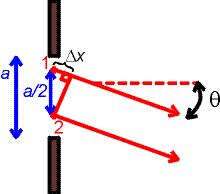






|

Single-slit
diffraction
 A
single slit, as shown on the right, also causes a
diffraction pattern. This results because the slit is of
finite width, and every point in the slit serves as a
source of a wave. Consider a slit of width a
where we will consider two points of emission, , one from
the upper half of the slit and one from the lower half.
The points will be separated by a/2.
For light that travels in the direction q, the contribution from point 1
will cancel the contribution from the point 2
if the difference Dx is a
half-integral number of wavelengths. Thus, there is a MINIMUM
for angles, A
single slit, as shown on the right, also causes a
diffraction pattern. This results because the slit is of
finite width, and every point in the slit serves as a
source of a wave. Consider a slit of width a
where we will consider two points of emission, , one from
the upper half of the slit and one from the lower half.
The points will be separated by a/2.
For light that travels in the direction q, the contribution from point 1
will cancel the contribution from the point 2
if the difference Dx is a
half-integral number of wavelengths. Thus, there is a MINIMUM
for angles,

For the first
minimum, m =
1, the formula looks exactly like the expression for the maximum
for the two-slit problem, only that one is
refering to the slit width a here,
whereas we refered to the slit separation d
in the two-slit problem.
Examples Interference
and diffraction's index
|








 A
single slit, as shown on the right, also causes a
diffraction pattern. This results because the slit is of
finite width, and every point in the slit serves as a
source of a wave. Consider a slit of width a
where we will consider two points of emission, , one from
the upper half of the slit and one from the lower half.
The points will be separated by a/2.
For light that travels in the direction q, the contribution from point 1
will cancel the contribution from the point 2
if the difference Dx is a
half-integral number of wavelengths. Thus, there is a MINIMUM
for angles,
A
single slit, as shown on the right, also causes a
diffraction pattern. This results because the slit is of
finite width, and every point in the slit serves as a
source of a wave. Consider a slit of width a
where we will consider two points of emission, , one from
the upper half of the slit and one from the lower half.
The points will be separated by a/2.
For light that travels in the direction q, the contribution from point 1
will cancel the contribution from the point 2
if the difference Dx is a
half-integral number of wavelengths. Thus, there is a MINIMUM
for angles,